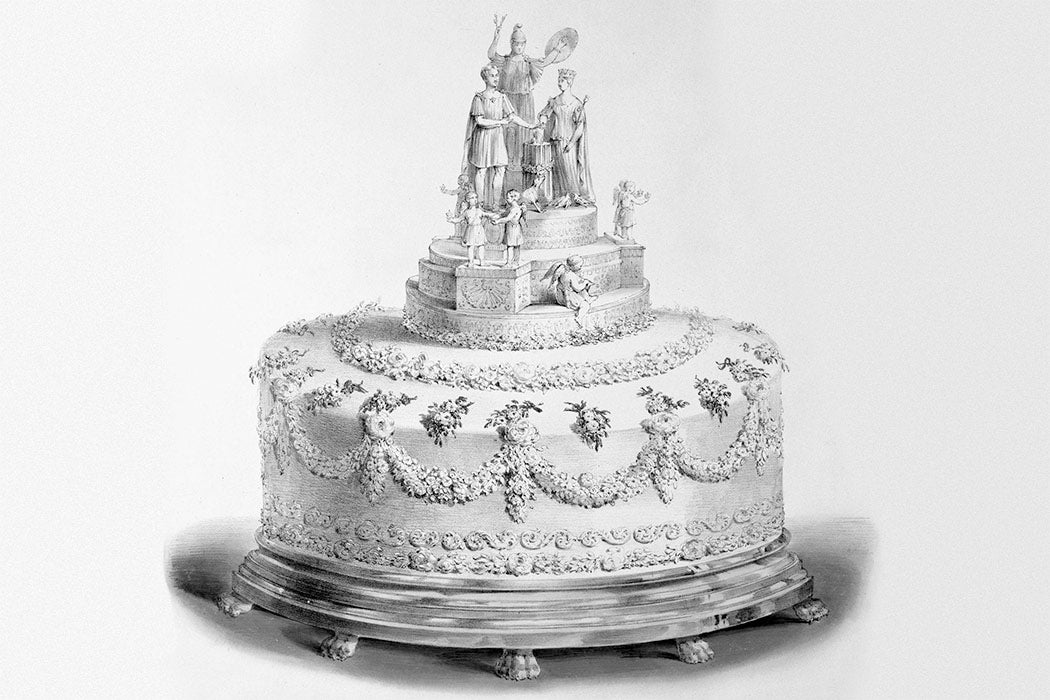
In the lead-up to a royal wedding, just about anything can become news. Take Meghan Markle and Prince Harry’s wedding cake: In March, Kensington Palace announced that it will be a lemon elderflower cake covered in buttercream that “will incorporate the bright flavours of spring.”
For royal watchers, that news is sweet indeed, and the cake has already inspired everything from copycat recipes to complimentary cocktails. But why the big fuss? Victorian literature scholar Emily Allen knows the answer—the cake, like Queen Victoria’s, will be a type of culinary spectacle that reveals more about the spectators than it does about the bridal couple themselves.
At the time, wedding cakes were usually single-layer fruitcakes covered in stiff white icing—the stuff of years of English tradition. But in the nineteenth century, a French invasion of sorts swept the nation’s kitchens. It became chic to eat Frenchified foods as a way of showing off wealth and good taste. What better way to display that taste than at your own wedding?
Victoria’s wedding cake, though a thoroughly English plum cake on the inside, had some French decorative flair on the outside. It weighed 300 pounds, and was fourteen inches tall and ten feet wide, “was ornamented by sculptures of Britannia, the royal pair in Roman costume, and one of Victoria’s ubiquitous canines, to suggest fidelity,” Allen writes.
Before being eaten, the cake drew quite a crowd. The “distinctly ruly mob” queued up outside of the store where it was created, waited in line for a glimpse, then trotted into the store two by two to get a peek.
It was spectacular—and, Allen writes, it created a media frenzy. Significantly, Allen notes that this was the start of a British tradition: instead of eating the cake or even seeing it in person, much of British society learned about it by looking at lavish illustrations and reading first-hand accounts published in newspapers.
These “strategies of looking” turned Britain into a “nation of spectators” who came together to look at something that was for them but not for them—a wedding and a cake that was primed for public “consumption,” but made for the inaccessible upper class only. Queen Victoria’s wedding was a glorious, unifying performance acted out on a national stage. Accordingly, her cake a delicious-seeming confection that was to be seen, but not necessarily eaten.
For Allen, the people who obsessed over Victoria’s cake became part of the queen’s wedding performance. “In the act of consuming the page she not only participated in but also performed the wedding ceremony, espousing its ideological assumptions,” she writes. “However passive, looking thus became a performative act.”
Harry and Meghan’s wedding will be a performance, too. And as we consume their nuptials and fantasize about that buttercream icing, we’ll become part of the performance, too.
SaveSave
SaveSave
JSTOR Citations
Culinary Exhibition: Victorian Wedding Cakes and Royal Spectacle
Victorian Studies, Vol. 45, No. 3 (Spring, 2003), pp. 457-484
Indiana University Press
Read Again https://daily.jstor.org/englands-obsession-with-queen-victorias-wedding-cake/Bagikan Berita Ini














0 Response to "England's Obsession with Queen Victoria's Wedding Cake"
Post a Comment